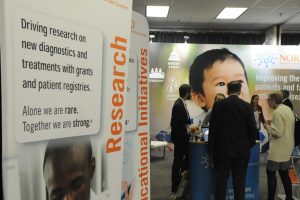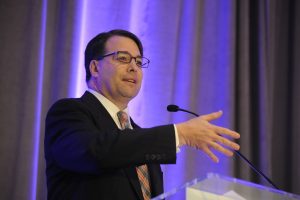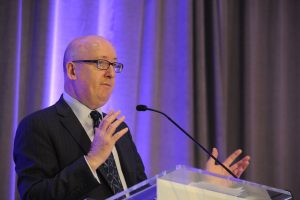#NORDsummit – Despite Criticism, Orphan Drug Act Is Working to Advance Needed Treatments, FDA Says

Copies of a report commissioned by NORD on the Orphan Drug Act. (Photo: Larry Luxner)
As Congress begins debate this week to overhaul the U.S. tax code, lawmakers should leave the Orphan Drug Act (ODA) — and the tax incentives it offers pharmaceutical companies to develop therapies for rare diseases — off the table.
That’s the message being pushed by the National Organization for Rare Disorders (NORD). The nonprofit group commissioned a study, released Oct. 17, by the QuintilesIMS Institute to bolster support for the Orphan Drug Act among U.S. lawmakers — and to counter charges that pharmaceutical companies manipulate the incentives offered by the landmark act, signed into law by President Reagan in 1983.
The 32-page report, “Orphan Drugs in the United States: Providing Context for Use and Cost,” found that approved drugs for orphan indications accounted for only $36 billion, or 7.9 percent, of the $460 billion Americans spent on pharmaceuticals in 2016.
“As you all know, there’s been lots of noise in the marketplace about the Orphan Drug Act and its impact,” said Peter Saltonstall, NORD president and CEO, speaking Tuesday at his organization’s annual two-day Rare Diseases & Orphan Products Breakthrough Summit in Washington, D.C.
“We, as the patient organization that essentially birthed the Orphan Drug Act 35 years ago, thought it was important to lay out the case factually,” Saltonstall told about 670 summit participants. “We realize that orphan drugs are very emotional, but we want to take the emotion out of the conversation and build our case around facts.”
One key fact, according to the report, is that although the median annual cost for an orphan drug in 2016 was $32,880, the top 10 therapies used by most patients averaged $14,909.
The Orphan Drug Tax Credit (ODTC) allows sponsors with orphan designation to collect tax credits for expenses incurred running clinical trials of potential therapies for the indicated rare, or orphan, disease. This tax credit lowers the cost of drug development; according to NORD, 33 percent fewer rare disease drugs would be developed without the credit.
A case in point is Kalydeco (ivacaftor) — a therapy approved for the symptomatic treatment of cystic fibrosis. Developed by Vertex Pharmaceuticals, the drug is effective in patients with the G551D mutation and R117-H-CTFR mutation, among others. It is the first therapy to address the underlying cause of CF rather than treating only its symptoms.
Before Kalydeco’s approval in 2012 by the U.S. Food and Drug Administration (FDA), only one other therapy for CF existed. Five years later, Kalydeco received FDA approval to treat 23 other CTFR mutations — bringing the total of CF-causing gene mutations this therapy can treat to 33.
“The Orphan Drug Act has been supporting orphan drug development for over three decades through tax credits for clinical research, waiver of user fees, and seven years of market exclusivity,” said Mike Lanthier, an operations research analyst at the FDA.
“Prior to the ODA, we didn’t really see a whole lot going on — an average of one new drug approval per year,” he said. But between 1983 and 2016, the FDA approved 451 orphan drugs for 590 rare disease indications. “My sense is that the Orphan Drug Act has been a successful catalyst for spurring rare disease development.”
In addition, more than a quarter of orphan approvals since 2013 have received breakthrough therapy designation, while nearly three-quarters have received priority review designation, which the FDA grants to drugs which treat a serious condition.
“The pace of annual novel orphan approvals has doubled since 2011, and new indication approvals to existing treatments have greatly increased since 2013,” Lanthier said.
In the 1980s, he added, about 23 percent of orphan approvals were biological in nature — a number that has risen to 42 percent so far this decade.
Likewise, in the 1990s, therapies that target subsets of rare disease patients, with a specific condition, accounted for only 1 percent of all orphan drug approvals. Today, his analysis found that targeted therapies represent 14 percent of such approvals.
As for accusations that big pharma often take advantage of the ODA’s tax and other incentives by repurposing existing drugs to treat rare diseases, Lanthier said his research shows this simply isn’t true.
“Over 80 percent of orphan drug products were initially approved as solely rare disease treatments. Less commonly, a drug is first approved for marketing to treat a non-rare condition, but later adds one or more orphan indications,” the FDA official said.
“Nearly three-fourths of drugs initially approved as an orphan drug have not expanded their labeled indication, and fewer than 10 percent of initial orphan approvals have added a non-rare indication to their label,” Lanthier added. “Most drugs that encounter the ODA start out as a rare disease treatment and remain a rare disease treatment, although there are exceptions.”
Murray Aitken, senior vice president and executive director of QuintilesIMS, said annual growth rates for orphan drug sales have varied between 6 and 16 percent over the past decade as more drugs have become available. Last year, 58.5 percent of U.S. drug sales were non-orphan traditional, 33.6 percent were non-orphan specialty drugs, and 7.9 percent were orphan drugs.
Spending on orphan drugs has also increased at a lower rate than specialty drugs over the past five years. Between 2012 and 2016, traditional non-orphan drug expenditures have grown 25 percent, while orphan drugs have grown 51 percent and specialty non-orphan drug spending by 84 percent.
In his presentation, “Commercial Market Dynamics for Orphan Drugs,” Aitken said that while extremely expensive drugs like Spinraza to treat spinal muscular atrophy (at $750,000 for the first year of treatment) and Brineura to treat a specific form of Batten disease ($702,000 per year) often grab media attention, such therapies are the exception rather than the rule.
“Almost two-thirds of total orphan drug sales come from drugs with annual costs of less than $100,000. Of the 335 orphan drugs, 22.4 percent cost less than $6,000 a year, while another 367 percent cost between $6,000 and $50,000,” said Aitken. “We do feel it’s important that policy decisions get made based on evidence rather than anecdotes or headlines.”










Leave a comment
Fill in the required fields to post. Your email address will not be published.